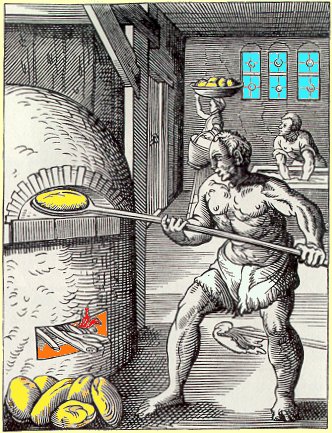What Did the Ancients Eat?
Today, what did the ancients eat? The University of Houston's College of Engineering presents this series about the machines that make our civilization run, and the people whose ingenuity created them.
Technology has often radically altered the food we eat. Harnessing fire some half-million years ago not only meant cooked meat, it also meant that many vegetables that would've been inedible could now be eaten. We've found useable ovens from the preagricultural world of twenty thousand years ago. Another milestone was the widespread rise of pottery some twelve thousand years ago. With pottery, we gained means for storing foods.
When we turned from hunter-gatherers into farmers and settled down to live in one place, we ate more grain and dairy products. That led to using yeasts and fermentation to preserve food. We began baking leavened bread, making cheese, and brewing beer.
In their book Ancient Inventions, Peter James and Nick Thorpe describe how the ancients ate. The great civilizations of the Mideast added the important element of vegetable oils to their diets -- corn oil, olive oil, rape seed and sesame seed oils.
The use of sugar first became widespread among Arabs in the seventh century. But the use of honey and various fruit juices as sweeteners goes back into prehistory. Imported Oriental spices were already very popular in ancient Rome. They were used both to preserve food and to enhance its flavor.
The fast-food shop was created in the large ancient cities. Chinese noodle-shops became very popular in the first and second centuries A.D. The urban Roman ate from street stalls that served various meats and breads, and wines that were usually thinned with water. The oldest known fast-food shop was found in the Sumerian city of Ur. It operated in 1800 B.C.
Rome has left us Apicus' book, On Cookery. Apicus himself is somewhat mysterious. Three famous gourmands by that name lived during the period from the late first century B.C. through the early second century A.D. Perhaps the name of Apicus was simply tacked on to a book assembled by other people.
James and Thorpe offer some of its recipes expressed in modern units. Roman custard is fairly simple. Preheat your oven to 325 degrees. Then heat two cups of milk and a quarter cup of honey in a saucepan without letting it boil. Stir in three beaten egg yolks and a quarter teaspoon of nutmeg and pour it into a baking dish. Bake it for an hour in the oven, then garnish it with more nutmeg.
Apicus' recipe for asparagus in wine really makes my mouth water. I'll include it for you in the written transcript.
Looking at all this, I wonder ... If I found myself in, say, ancient Rome, able to speak Latin and carrying a pocket full of denarius coins, how would I have liked the food? The taste would run more to spice, less to sweetness. More oils and fats, lots of bread, meat and fruit -- fewer fresh vegetables. I wonder. Perhaps I need to go home and make that custard.
I'm John Lienhard, at the University of Houston, where we're interested in the way inventive minds work.
(Theme music)
P. James and N. Thorpe, Ancient Inventions. New York: Ballantine Books, 1994, Chapter 7.
The following recipe for Asparagus in Wine is given by James and Thorpe (above) on page 319.
1 pound asparagus
1 ½ cups white wine
1 cup vegetable stock
2 teaspoons olive oil
2 teaspoons finely chopped onion
¼ teaspoon ground pepper
1 teaspoon celery seeds
1 teaspoon ground coriander
¼ teaspoon savory
1 raw egg yolk, beaten
Pepper and salt to taste
Finely chop the asparagus shoots and place in a mortar. Pound them into a paste; add the wine and steep for about half an hour. Strain through a colander, reserving the wine. In a pan, mix together ¼ cup of the wine, the stock, olive oil, onion, herbs and spices. Add the asparagus purée, bring to a boil, lower the heat and simmer for 15 minutes. Allow to cool slightly, add the beaten egg yolk and season with pepper and salt.
